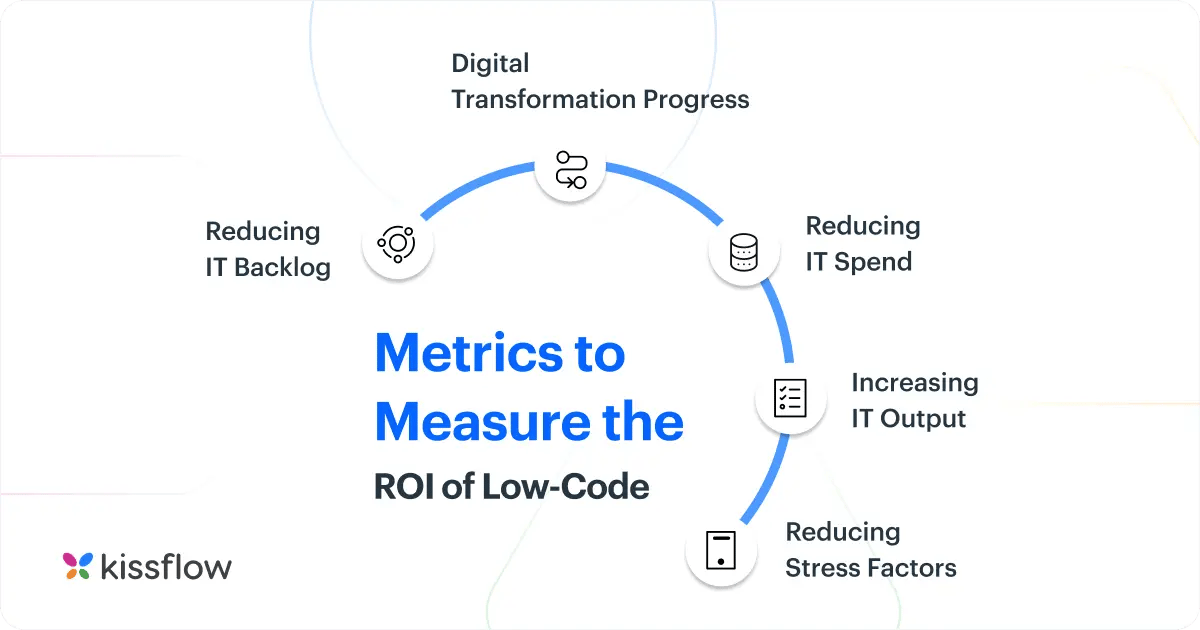-1.webp?width=500&height=300&name=How%20to%20Measure%20Low%20Code%20ROI%20For%20Your%20Enterprise%20Business%20(1)-1.webp)
- >
- Low-Code Platform >
- How to Measure Low Code ROI For Your Enterprise Business
How to Measure Low Code ROI For Your Enterprise Business
Team Kissflow
Updated on 23 Apr 2025 • 10 min read
Now that you know how companies can use low-code platforms, how can you tell if it will generate any ROI? Many CIOs and IT leaders can easily list a few advantages of low-code, but not very many have a specific way to measure if it is living up to its cost.
A low-code platform is an investment for any IT department. For a small organization, the annual price may start in the low thousands of dollars, but quickly scales to hundreds of thousands of dollars for an enterprise-level solution.
Metrics to Measure the ROI of Low-Code
So how can CIOs and other IT leaders see and demonstrate the real value they get from low-code?
You can create a whole lot of metrics to judge the success of low-code, but here are five options (that you are probably already tracking) that can help you show whether or not you are getting your money’s worth from a low-code platform.
- Reducing IT Backlog
- Digital Transformation Progress
- Reducing IT Spend
- Increasing IT Output
- Reducing Stress Factors
We’ll examine each of these in greater detail to show how you can demonstrate the ROI from a low-code development platform.
Measuring Low-Code ROI For Enterprise Businesses

1. Reducing IT Backlog
Perhaps the most common two-line phrase heard in IT departments is “Yes, that’s possible. No, I can’t work on that right now.”
Advancements in technology have opened up many doors, but IT teams are limited in how many of them they can walk through at a given time. As the demand for more custom applications mounts, most IT teams don’t have an effective way to handle it.
One area where a low-code platform should have a significant effect is on reducing the number of IT application requests and/or allowing developers to work through them faster.
As departments see the power of digital tools and automation, their demands for custom applications grow. However, most of these end up being long-tail requests that sit at the bottom of a priority queue for months, if not years, at a time. And with development time for traditional applications estimated at 3-6 months, you are looking at an ever-expanding list of tools to make.
A low-code platform geared toward citizen developers lets you offload the responsibility for creation of these applications from the IT team onto the business leaders themselves. After a simple training on the platform, users should be able to create their own applications. If you choose a platform with built-in chat support, you can watch your IT backlog shrink dramatically with absolutely no additional effort.
Recent reports indicate that 71% of organizations that leverage citizen development have sped up application development by at least 50%, and 29% of companies have seen a 2X or more jump in delivery time. 90% of developers who use a low-code platform have less than five app requests per month in backlog.
Track the number of requests you currently have for custom applications. Invite business leaders to submit their wish list for new tools. Make an assessment of how long it would take your IT team to clear off all the requests without a low-code platform.
Compare the complete list with the capabilities of the low-code platform. Which apps could be made by the requester, and which ones are complex enough that they require IT to be involved? How quickly could the request queue be reduced?
Experience the power of low-code with the simplicity of no-code.
2. Digital Transformation Progress
Right after “not drowning in requests”, every CIO’s second biggest priority is digital transformation. All companies are in the process of digital transformation, whether just starting or trying to finish the last mile.
After the main systems of an organization are digitized, IT teams are often faced with a never-ending list of processes and systems that need to be brought into the digital fold. The task is overwhelming, and most solutions don’t scale.
Traditional methods of app development mean there is no end (and seemingly very little progress) in sight. Accelerating digital transformation was the top reason the most IT leaders chose a low-code platform, with 69% focusing on finishing the work of digital transformation. Implementing a low-code platform should greatly advance the IT leader’s march towards a complete digital takeover.
How to Measure
Use your current digital transformation roadmap. What realistic benchmarks have you currently set? After implementing a low-code platform, how would your roadmap change? What requirements are simple enough that a business user could bring his or her own department into a fully digital space? How much time could you eliminate from the entire transformation roadmap? How much more complete of a transformation would be possible?
Proving the ROI
McDermott is a large Oil and Gas infrastructure company with revenues of nearly $3 billion. They pursued a low-code solution to advance their digital transformation efforts. “Once you take steps towards digitisation, change management across the organisation becomes much easier,” said CIO Akash Khurana. “People feel part of the transformation. They see the benefits of the initiatives you are running and are much keener to get involved.”
In 2015, McDermott had a 6,500-strong user base across four major sites around the world. But with an IT team of only six support members, they were not able to keep up on requests to automate simple processes from several departments. “We came up with close to 50 backlogged workflow requests from just two functions,” said Renee Villarreal, Senior Manager of Global Application Management and Support.
Kissflow’s no-code platform was the key for McDermott’s final decision. “As soon as our business leads saw any kind of coding, they just shut down–they were not interested. Kissflow has none of that; they loved it immediately,” said Renee.
McDermott started using Kissflow only for the finance and supply chain teams, but after six months, decided to purchase licenses for the entire company.
Support for Kissflow went first to the business leads themselves and then to Kissflow directly. This was a huge asset for the IT team to provide a valuable digital service for the entire company without having to be involved in support, maintenance, and upgrades.
Currently, McDermott has 6,000 users on the Kissflow platform, and 130 business users across 15 departments creating their own apps.
In the first year, they successfully processed 23,000 items, saving immense time and effort. In that same year, they only raised about 30 support tickets to help them build their workflows.
3. Reducing IT Spend
While IT budgets are not extremely tight right now, the technology development has always had a scaling problem. With traditional programming methods, the only way to tackle mammoth problems is with a mammoth budget. Demonstrating the ability to address issues while not adding exponential costs further puts the CIO and IT leader in an advantageous business position.
There are two main ways a low-code platform can save costs. The first is preventing an excessive labor pool. To accomplish the application needs of the organization, the simplest solutions are to hire more developers, or hire IT consultants. Both options are expensive, and neither one scales well. A low-code platform will prevent you from having to hire additional staff or consultants because, either your current team will be more productive, or the business leaders will create the apps themselves.
The second cost savings opportunity is a result of each department spending money on a single-point solution. Procurement finds their own software to use, HR, finance, marketing, and operations all do the same. Large organizations might have dozens of these solutions that only solve one problem, but essentially each with a similar technology. Research shows that a low-code solution can replace eight single point tools.
Depending on how the low-code platform is priced determines how much ROI you can recover. A low-code tool priced per user often allows you to create an unlimited number of apps on the platform, with the cost of each app going down the more apps you create. Platforms that are priced on a per-app basis will offer more firmly correlated cost savings based on how many apps you create.
A further cost advantage of having a low-code platform is not just in meeting current requirements, but future ones also. Many companies select a low-code platform to solve a current challenge, only to find that there are other solutions that it can offer as well. The success of new self-built automated apps often cause the need for more of the same, and what is created in the end is much greater than what was originally anticipated.
How to Measure
One metric you will use: what would it cost me to build the same number of apps with and without the low code platform?
Given the current demand for custom apps, how many additional staff would you require to complete all the work in a desired time frame? What would be the complete cost to the company for these additional resources?
Another part of the equation is the current cost of all the single-point solutions used across the organization? What solutions have been rejected/delayed due to no additional budget? Could all of these needs be created with custom apps from a low-code platform? What would the current/potential savings be?
Proving the ROI

Caratlane, India’s largest online jewelry retailer, has offices and warehouses all over the country. To operate, their teams need to be in constant communication with each other, so that customer needs are not only met but exceeded, to retain customer loyalty and trust.
Their teams needed one solution to solve warehousing, quality checks, accounts, and customer service. But to go to their internal IT team would mean waiting months for solutions to roll out, and they needed something much sooner. Their motivation was to reduce the IT backlog and spend.
They chose to use a low-code process platform. Now, Chief Product Manager Ajit Singh didn’t need to worry about IT backlogs, since his own teams could create the processes. As Ajit said, “Developers in an organization are scarce. It’s better to manage things ourselves, especially if we have short timelines.”
He used Kissflow to create the applications he needed. “I designed it, tested it and had it ready in a week. The platform is simple and highly intuitive, so anyone can use it.”
With Kissflow’s no-code development platform, Ajit Singh was able to create all the applications he needed for warehousing, quality checks, accounting, and customer service. And he was able to do it all in a matter of days, instead of the months it would have taken with hand coding and IT involvement.
.webp?width=260&height=260&name=5_metrics_to_measure_the_roi_of_low_code-1%20(1).webp)
5 Clear-Cut Metrics to Measure the ROI of Low-Code
Thank you for reaching us!
Thank you for reaching us!
4. Increase IT Output
If you implement a low-code solution that allows citizen developers to create their own tools, what happens to your existing IT team? Are they in danger of losing their jobs? Not likely.
Introducing a low-code solution should increase the quality, speed, and impact of the current IT team. If business leaders are creating all their own specific long-tail applications, that allows the IT team to turn its focus onto those large, mission-critical projects that require their skillset.
When using a low-code platform, it’s easy for developers to make the shift to rapid application development (RAD), which helps them produce apps faster, better, and closer to spec. Using a low-code tool, prototyping and iterating apps can happen nearly instantaneously. No more long delays between meetings to demonstrate how new apps will function. The turnaround time for the IT team to complete apps is dramatically reduced.
Modularized building blocks also reduce the chance for bugs and assure both developers and users that the app will be functional from the first deployment.
But the largest gain for the IT team from implementing a low-code platform is that they will have additional time and space to focus on the larger, money-making applications. Developers can spend more of their time making a greater impact on the core business rather than chasing after every application request that comes across.
How to Measure
Examine the last few quarters of the output from the IT team. How long did it take to create most of the applications? What kind of energy is spent in maintaining and updating old applications? What kind of business impact have new applications had?
What would be the result if developers had more time to focus on mission-critical projects? How would they use the time gained from a low-code platform?
5. Reduce Stress Factors
One of the most common (but least discussed) reasons for turning to a low-code solution is simply the level of chaos that most IT teams are constantly facing. From unhappy and hostile business leaders who want apps made faster to the stress of a mounting queue of requests and escalations, there seems to be no end to the level of stress that IT leaders are under.
While potentially the hardest to quantify, this return might be the most valuable. A low-code platform should greatly reduce the amount of stress factors facing the IT team and the business in general.
Part of being in IT is negotiating lead times as well. When deadlines aren’t met, tensions rise. Studies showed that among IT teams that used low-code solutions, business units were 21% happier with lead times than among those without low-code.
How to Measure
How much time does your IT team currently spend on support tickets, feature enhancements, and escalations around existing applications? Shifting to a low-code platform should greatly reduce these.
Does your IT team feel like they are valuable contributors to the company mission? If your team is demotivated by building small apps or just maintaining existing apps, they may begin to look elsewhere for more challenging work.
What projects have you said “no” to recently? When the IT team is swamped with existing tasks, there is a lot of opportunity lost and added stress by turning down and diverting high-impact projects.
How do other business units feel towards IT? Take a survey of other business leaders to ask how they feel about IT. Are they satisfied by the response time, development time, and other metrics? A low-code development platform can go a long way to improve these relationships as IT becomes an enabler rather than a stopgap.
Proving the ROI

The YMCA of Chicago was in a season of phasing out a lot of old tools, including the use of Lotus Notes and some IBM AS400s. At the same time, they had several processes which had become very cumbersome to run.
Program managers came to IT Project Manager Matthew Robinson to create a solution. While extremely capable of building custom solutions, Matthew did not have the time or bandwidth to create custom applications for all of these requests. With a small IT team, the YMCA of Chicago always has to do a lot with a little.
In order to save them time, the YMCA of Chicago chose to use Kissflow as a low-code process platform. The program managers were impressed at how quickly the IT delivered the solution, but more so, how efficient the solution was.
Using a low-code platform has significantly reduced the stress and chaos around their current processes. They are able to handle more than 60 facility requests per month, and track and manage each request in a much more efficient way than before. YMCA Chicago has found a great ROI for using Kissflow, and are looking at more processes to automate to further increase their return.
Which Low-Code Platform Is Right for You?
Whether you are a large enterprise or an emerging SMB, a low-code platform can provide lots of dividends. Armed with new metrics, you can experiment with new low-code solutions to see which one is right.
Identifying your primary success metrics is the best place to start. Are you primarily looking for a tool for decreasing the IT backlog? Reducing stress? Advancing digital transformation?
Also think through the type of platform you need. Do you require a full-service general purpose platform, or do you want something that focuses on processes, requests, or databases?

The Ultimate Beginner's Guide to Low-Code | Free eBook
Thank you for Downloading!
Why Kissflow is the Best Low-Code Platform
Kissflow is a great place to start your low-code exploration. It is the ideal tool if you want to open up process application creation to everyone in your organization. Kissflow goes beyond low-code, and provides a completely code-free environment that anyone in your organization can use to create an automated process. And with a per-user pricing plan, it is one of the most affordable options as well.
Try Kissflow using our free trail now.
Related Articles



![App Development using Low-code Platform [Faster Method] | Kissflow](https://kissflow.com/hs-fs/hubfs/app-development.webp?width=352&name=app-development.webp)








